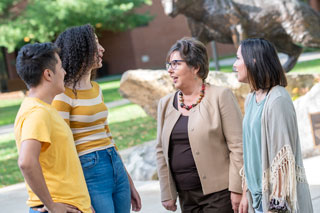Koverola settling in to campus
Plans to build on momentum

Dr. Catherine Koverola, president of the University of Pittsburgh at Bradford, has experienced and witnessed education’s power to transform people, families and communities.
Education transformed her, the daughter of humble, hardworking people who emigrated from Finland to Canada in the hopes of making a better life. Since then, Koverola has spent more than three decades watching education uplift others.
As Pitt-Bradford’s fourth president, she wants to ensure Pitt-Bradford students have the kinds of extraordinary experiences that will transform them.
Koverola arrived at Pitt-Bradford in April 2019 at a good time. Over the last several years, Pitt-Bradford’s student population has remained robust and mostly residential but also more diverse, which Koverola said is a “testament to the warm, caring hearts of Bradfordians who welcomed and continue to welcome all of these students.”
Last fall, the university recruited its largest and most diverse freshman class in its 56-year history. Of the 442 new students – a 19% increase over the previous year – 38% were racial minorities: 20.4% black students, 8.6% Hispanic students, 4.5% multi-racial students, 3.9% students of Asian descent, and .5% Native American.
She plans to build on that momentum as she and other faculty and staff members develop the university’s next strategic plan. Woven throughout that plan will be three guiding and student-centered principles: ensuring Pitt-Bradford is an inclusive, welcoming community for everyone; preparing students to be global citizens; and tending to all of the students’ needs -- mind, body and spirit.
Koverola also takes seriously Pitt-Bradford’s role in the Bradford community and the importance of infusing into the area new and innovative ideas and opportunities to help neighboring communities and their residents prosper.
“It is important that our faculty, staff and students connect our neighbors to new ideas, innovative research, and existing arts and cultural programming,” she said. “It also is vital that we all work together to build opportunities for continued regional development and growth.”
“One way to bolster the region is by keeping graduates here to infuse new, innovative and exciting ideas that can help our communities grow and prosper.”
That is the impetus behind two new engineering technology programs, developed to meet regional workforce needs and keep talented young people here.
For years, local and regional businesses and manufacturers struggled to fill vacant positions. Young men and women interested in STEM-related fields were leaving the region to enroll in other colleges and universities, often not returning when they earned their degrees.
“Our community members watched as other areas grew and prospered while our own area lagged behind,” Koverola said. “We knew we had to make some bold moves to change this situation.”
With support and guidance from area engineers and employers, university officials developed and received approval for two new bachelor degree programs in mechanical engineering technology and energy engineering technology, which are expected to launch in fall 2022.
University officials are now working on creating the appropriate space, a new 37,000-square foot STEM building, which will house the new engineering technology programs as well as the existing computer information systems and technology program and the petroleum technology program.
The building, which will be located adjacent to Hanley Library, will feature the spaces students in these majors will need to help spark their creativity, including a machine shop, a linear circuit/electronics lab, a measurements, virtual reality and augmented reality lab, and a solid modeling computer simulation lab.
“What’s most exciting is we won’t have to wait long to see the impact of these new programs and this new building,” Koverola said. “We expect to recruit about 60 more students into the new engineering technology programs. When they graduate in four years, along with the CIS&T and petroleum technology students, it will be more than 100 new well-prepared graduates to infuse into the region an influx of innovation.”
Koverola and others also are looking beyond the region to identify additional opportunities.
“When I first came to Bradford, I was so impressed by all of the local companies that conduct business globally,” Koverola said, “proof that we live in a global society no matter how small our community may be. Therefore, we must prepare our students to be global citizens. One way to do that is to give students opportunities to immerse themselves in other cultures.”
During her long career in higher education, Koverola has made many connections throughout the world, which she hopes to capitalize on by establishing partnerships with international universities to increase global experiences for Pitt-Bradford students.
In May, she will be part of a team that will be traveling abroad in the hopes of establishing partnerships that will lead to developing new study-abroad opportunities for students and establishing student and faculty exchanges.
Additionally, Koverola hopes to spark the interests of international students to attend Pitt-Bradford.
Currently, the campus community includes students from 21 different countries, including Bangladesh, China, Dominican Republic, Ghana, Indonesia, Japan, Nepal and the Philippines.
“Pitt-Bradford is truly a gem,” Koverola said. “There are many students throughout the world who would appreciate the beauty of this campus, the welcoming and inclusive environment here, and the rigorous academic programs we offer.”
“This is an exciting time to be at Pitt-Bradford as we develop our vision for the future, which we hope will help to transform our students as well as our community.”